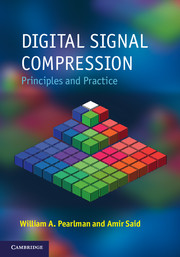Book contents
- Frontmatter
- Contents
- Preface
- Acknowledgments
- 1 Motivation
- 2 Book overview
- 3 Principles of lossless compression
- 4 Entropy coding techniques
- 5 Lossy compression of scalar sources
- 6 Coding of sources with memory
- 7 Mathematical transformations
- 8 Rate control in transform coding systems
- 9 Transform coding systems
- 10 Set partition coding
- 11 Subband/wavelet coding systems
- 12 Methods for lossless compression of images
- 13 Color and multi-component image and video coding
- 14 Distributed source coding
- Index
- References
11 - Subband/wavelet coding systems
Published online by Cambridge University Press: 05 June 2012
- Frontmatter
- Contents
- Preface
- Acknowledgments
- 1 Motivation
- 2 Book overview
- 3 Principles of lossless compression
- 4 Entropy coding techniques
- 5 Lossy compression of scalar sources
- 6 Coding of sources with memory
- 7 Mathematical transformations
- 8 Rate control in transform coding systems
- 9 Transform coding systems
- 10 Set partition coding
- 11 Subband/wavelet coding systems
- 12 Methods for lossless compression of images
- 13 Color and multi-component image and video coding
- 14 Distributed source coding
- Index
- References
Summary
In this chapter, we shall describe coding systems, primarily for images, that use the principles and algorithms explained in previous chapters. A complete coding system uses a conjunction of compression algorithms, entropy coding methods, source transformations, statistical estimation, and ingenuity to achieve the best result for the stated objective. The obvious objective is compression efficiency, stated as the smallest rate for a given distortion for lossy coding or smallest rate or compressed file size in lossless coding. However, other attributes may be even more important for a particular scenario. For example, in medical diagnosis, decoding time may be the primary concern. For mobile devices, small memory and low power consumption are essential. For broadcasting over packet networks, scalability in bit rate and/or resolution may take precedence. Usually to obtain other attributes, some compression efficiency may need to be sacrificed. Of course, one tries to obtain as much efficiency as possible for the given set of attributes wanted for the system. Therefore, in our description of systems, we shall also explain how to achieve other attributes besides compression efficiency.
Wavelet transform coding systems
The wavelet transform consists of coefficients grouped into subbands belonging to different resolutions or scales with octave frequency separation. As such, it is a natural platform for producing streams of code bits (hereinafter called codestreams) that can be decoded at multiple resolutions.
Information
- Type
- Chapter
- Information
- Digital Signal CompressionPrinciples and Practice, pp. 313 - 360Publisher: Cambridge University PressPrint publication year: 2011
